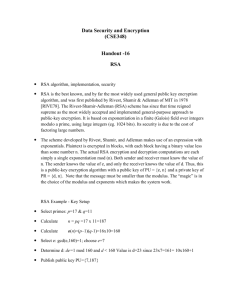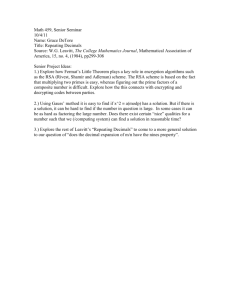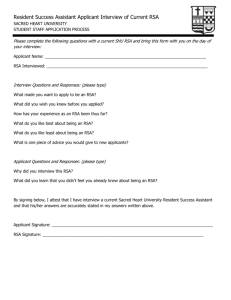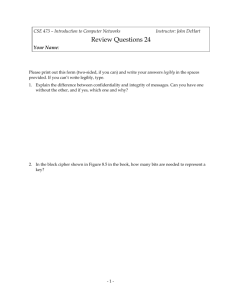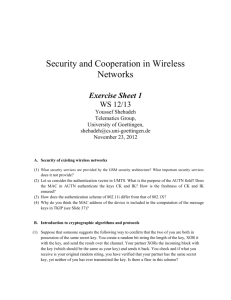Exam 1
advertisement
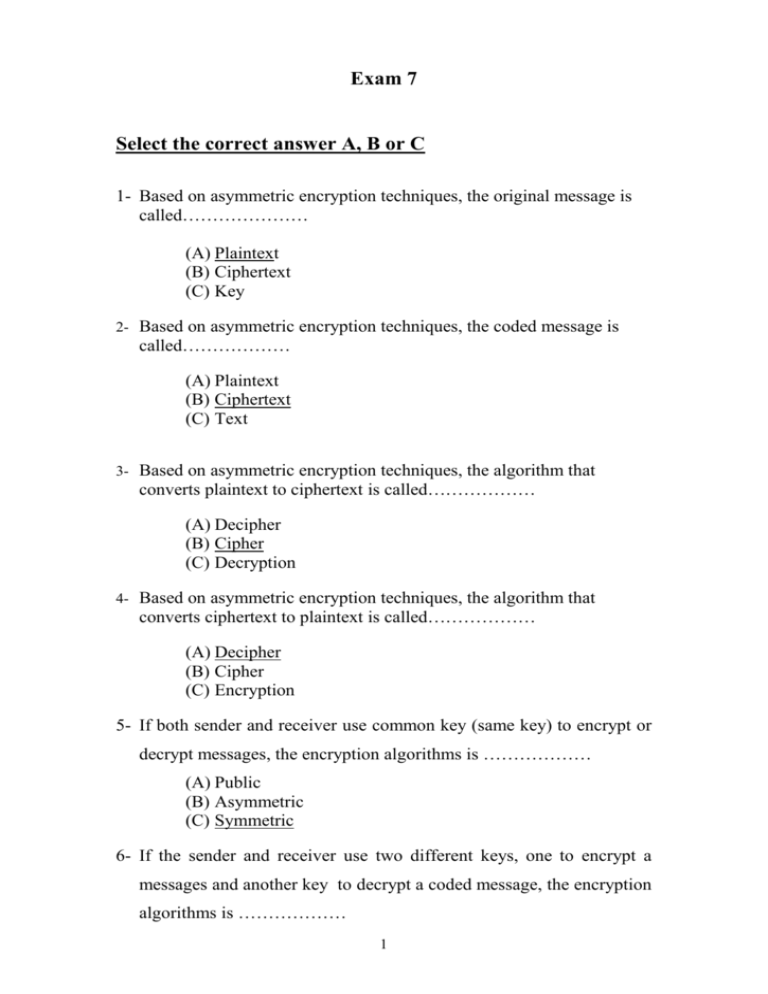
Exam 7
Select the correct answer A, B or C
1- Based on asymmetric encryption techniques, the original message is
called…………………
(A) Plaintext
(B) Ciphertext
(C) Key
2- Based on asymmetric encryption techniques, the coded message is
called………………
(A) Plaintext
(B) Ciphertext
(C) Text
3- Based on asymmetric encryption techniques, the algorithm that
converts plaintext to ciphertext is called………………
(A) Decipher
(B) Cipher
(C) Decryption
4- Based on asymmetric encryption techniques, the algorithm that
converts ciphertext to plaintext is called………………
(A) Decipher
(B) Cipher
(C) Encryption
5- If both sender and receiver use common key (same key) to encrypt or
decrypt messages, the encryption algorithms is ………………
(A) Public
(B) Asymmetric
(C) Symmetric
6- If the sender and receiver use two different keys, one to encrypt a
messages and another key to decrypt a coded message, the encryption
algorithms is ………………
1
(A) Private
(B) Asymmetric
(C) Symmetric
7- The attacker tries every possible key on a piece of ciphertext until
original plaintext is obtained, this type of attack is called……………
(A) Time Attack
(B) Cryptanalysis Attack
(C) Brute force Attack
8- Based on secrecy
model of public-key cryptography, the secrete
information used in cipher is ……..………………
(A) receiver public key
(B) sender public key
(C) sender private key
9- Based on secrecy
model of public-key cryptography, the secrete
information used in decipher is ……..………………
(A) receiver public key
(B) sender public key
(C) receiver private key
10- Based on authentication
model of public-key cryptography, the
secrete information used in cipher is ……..………………
(A) receiver public key
(B) sender public key
(C) sender private key
11- Based on authentication
model of public-key cryptography, the
secrete information used in decipher is ……..………………
(A) receiver public key
(B) sender public key
(C) receiver private key
12- To provide secrecy and
authentication using public-key
cryptography, what is correct from the following
(A) The sender encrypts the message using his public key then
he encrypts the output using the private-key of the recipient
2
(B) The recipient decrypts the message using his private key,
then he decrypts the output using the public-key of the
sender
(C) The recipient decrypts the message using his public- key,
then he decrypts the output using the private-key of the
sender
13- To provide secrecy and
authentication using public-key
cryptography, what is correct from the following
(A) The sender encrypts the message using his private key then
he encrypts the output using the public-key of the recipient
(B) The recipient decrypts the message using his public- key,
then he decrypts the output using the private-key of the
sender
(C) The sender encrypts the message using his public key then
he encrypts the output using the private-key of the recipient
14- Which of the following is an application of public-key
cryptosystem
(A) Steganography
(B) Key exchange of session keys
(C) protect against denial of service attack
15- Which of the following is an application of public-key
cryptosystem
(A) Protect against virus
(B) Digital signatures
(C) Protect against worms
16- RSA uses large integers, what is correct about RSA from the
following
(A) RSA security due to cost of factoring large numbers
(B) RSA security due to cost of brute force attack
(C) RSA security due to cost of solve discrete logarithmic
17- RSA uses large integers, what is correct about RSA from the
following
(A) RSA was developed based on product cipher
3
(B) RSA was developed based on Euler's Generalization of
Fermat's Theorem
(C) RSA was developed based on discrete logarithmic
18- RSA uses large integers, what is correct about RSA from the
following
(A) RSA was developed based on product cipher
(B) RSA was developed based on Euler's Generalization of
Fermat's Theorem
(C) RSA was developed based on discrete logarithmic
19- To encrypt a message M, what is correct about RSA from the
following
(A) The sender obtains public key of recipient KU ={e, N} then
e
computes C, C M mod N
(B) The sender obtains public key of recipient KU ={e, N} then
computes C, C Me mod (N)
(C) The sender obtains private key of recipient KR ={d, N} then
computes C, C Md mod (N)
20- To decrypt a ciphertext C, what is correct about RSA from the
following
(A) The receiver uses his public key KU={e, N} to compute M,
M Ce mod N
(B) The receiver uses his private key KR={d, p, q} to compute
M, M Cd mod (N)
(C) The receiver uses his private key KR={d, p, q} to compute
d
M, M C mod N
21- Based on RSA, if p=2357, q=2551 what is the value of "N", choose
one of the following
(A) 6012707
(B) 6007800
(C) 4908
4
22- Based on RSA, if p=2357, q=2551 what is the value of (N),
choose one of the following
(A) 6012707
(B) 6007800
(C) 4908
23- Based on RSA, if p=2357, q=2551 and e=3674911, what is the
value of "C" if M=5234673, choose one of the following
(A) 43217
(B) 36502
(C) 3650502
24- Based on RSA, if p=2357, q=2551 and e=3674911, what is the
value of decryption key (d), choose one of the following
(A) 422917
(B) 422191
(C) 4908
25- Based on RSA, if N=6012707 and d=422191, what is the value of
"M" if C=3650502, choose one of the following
(A) 5234673
(B) 5234736
(C) 524673
5

